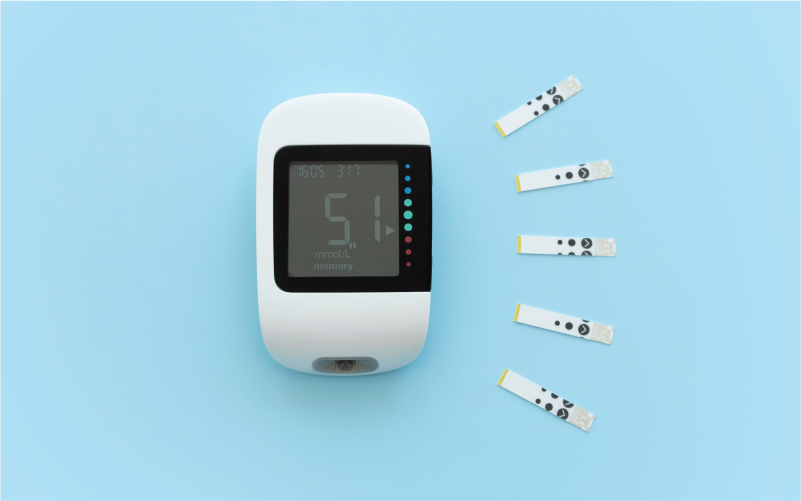Continuous glucose monitoring (CGM)
Continuous Glucose Monitoring (CGM) is a modern approach to diabetes management that involves a small sensor placed beneath the skin to monitor blood sugar levels continuously. This real-time data is then transmitted to a device, empowering individuals with diabetes to make timely decisions about their diet, medications, and lifestyle for effective blood sugar control.

How it Works
Continuous glucose monitoring (CGM) is a method used to track glucose levels in real-time throughout the day and night. It involves wearing a small sensor that is inserted under the skin, typically on the abdomen or arm. The sensor measures glucose levels in the interstitial fluid, which is a thin layer of fluid surrounding the cells. The sensor sends this data to a receiver or a smartphone app, which displays the glucose readings and provides information about trends and patterns in glucose levels over time.
When it is needed
Continuous glucose monitoring may be recommended in the following situations:
Diabetes management: CGM is commonly used by individuals with diabetes, both type 1 and type 2, to monitor their glucose levels continuously and make informed decisions regarding insulin doses, diet, and physical activity.
Hypoglycemia unawareness: For individuals who have difficulty sensing or recognizing the symptoms of low blood sugar (hypoglycemia), CGM can provide timely alerts and help prevent severe hypoglycemic episodes.
Insulin pump therapy: CGM is often used in conjunction with insulin pump therapy to provide accurate glucose readings for precise insulin dosing adjustments.
Gestational diabetes: Pregnant women with gestational diabetes may use CGM to closely monitor their glucose levels and manage their condition effectively.
Risks and Complications
While continuous glucose monitoring is generally safe and well-tolerated, there are some risks and potential complications to consider:
Skin irritation or allergic reactions: Some individuals may experience skin irritation or allergic reactions at the sensor insertion site. Proper sensor placement and regular site rotation can help minimize these issues.
Inaccurate readings: CGM devices may occasionally provide inaccurate glucose readings due to various factors, such as sensor calibration errors, sensor drift, or interference from medications or certain substances.
False alarms: CGM systems can sometimes generate false alarms, indicating high or low glucose levels when they are actually within the target range. This can lead to unnecessary actions, such as unnecessary insulin administration or glucose consumption.
Device-related issues: Technical malfunctions or device failures, although rare, can occur with CGM systems, leading to interrupted or inaccurate glucose monitoring.
It’s important to note that CGM should be used as an adjunct to standard blood glucose monitoring and should not replace regular fingerstick blood glucose checks. Close communication with healthcare providers and diabetes educators is essential to interpreting CGM data accurately and making appropriate adjustments to diabetes management.
Overall, continuous glucose monitoring is a valuable tool for individuals with diabetes, helping to monitor glucose levels continuously and make informed decisions about diabetes management. If you have specific concerns or questions about CGM, it’s recommended to discuss them with your healthcare provider or diabetes care team. They can provide you with more personalized information and guidance based on your individual health needs.







